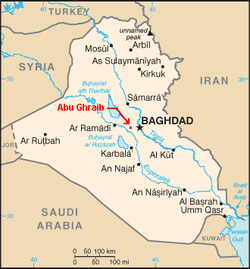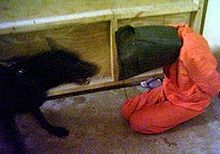Baghdad Central Prison
The Baghdad Central Prison (formerly Abu Ghraib prison ; Arabic سجن أبو غريب Sidschn Abū Ghuraib , DMG Siǧn Abū Ġurayb ) was a prison complex in Abu Ghuraib in Iraq until February 2014. Already in Saddam Hussein's time , the Abu Ghuraib prison wasnotoriousfor its torture practices. Executions are also said to have taken placethere regularly.
After the third Gulf War, the prison gained public attention in 2004 when it became known that US occupation forces were raping, ill-treating and torturing Iraqi inmates there, often to the point of death.
Torture scandal
In May 2004, reports and photos reached the media showing that US soldiers and intelligence officers in Abu-Ghraib regularly mistreated, tortured and, in around 100 cases, killed inmates. Both male and female prisoners were raped. The inmates were "90 percent ... innocent," said the then Abu Ghraib commander Janis Karpinski today.
More and more photos and details became known and sparked outrage worldwide. As a result, there were violent demonstrations against the United States, especially in the Arab world.
history
Construction and operation under the Saddam regime
During the Saddam regime, the prison was under the General Security Service (al-Amn al-Amm) and was the scene of torture and executions that killed thousands of political prisoners. It is estimated that up to 4,000 executions in 1984 alone. The human rights organization Amnesty International documented several mass executions in the 1990s, each of which resulted in the death of hundreds of prisoners. Several mass graves were discovered in the vicinity of the prison after the fall of the regime.
In 1993, thanks to the mediation of Hans-Jürgen Wischnewski , the German Kai Sondermann was released from prison after almost eight months of political imprisonment.
During the Second Gulf War in 1991, coalition troops prisoners of war, e. B. Members of the British SAS , detained.
An estimated 15,000 prisoners were held in 2001, including many Iraqi Kurds , Shiites and Iraqis of Persian origin, some of whom had been imprisoned there since the beginning of the First Gulf War in 1980. Many of the inmates had never been charged or convicted and had been in solitary confinement for years. Unconfirmed evidence suggests that individual prisoners were also abused for attempts as part of the Iraqi B and C weapons program.
In the spring of 2002, work began on expanding the complex, which was to be expanded by up to six cell blocks.
However, the prison was abandoned before the Iraq war began in 2003. After a general amnesty in October 2002 and the release of most of the prisoners, the Iraqi security forces evacuated the facility and destroyed almost all documents.
After the withdrawal, the facility was looted and parts were destroyed or damaged by fire.
American occupation
In 2003 the US Army captured the prison and occupied it as a result of the Iraq War. It was again the site of torture by American troops. While part of it was preserved as a prison or military prison , a large part of the facilities was expanded and converted into a military base . Due to its strategically valuable position in front of the city of Baghdad , the prison became the main transshipment point for arrested persons.
The prison was repeatedly exposed to attacks, some with mortars.
In the spring of 2004, the military leadership decided to expand the prison again due to overcrowding, thereby creating space for more than 8,000 prisoners. Part of the cell wing was also given to the local military.
In mid-2004, US President Bush announced the demolition of the prison and replacement with a modern high-security prison. But that never happened.
In September 2006 the US and Iraqi government closed the prison .
After the US left
The prison reopened as the Baghdad Central Prison on February 21, 2009 and was expected to have capacity for 15,000 inmates.
In the wake of the uprising in Iraq following the US withdrawal , Islamist insurgents attacked various prisons in the country on the night of July 21-22, 2013. 500 prisoners escaped from Abu Ghuraib prison. The terrorist group ISIS claimed responsibility for the prison release, in which between 25 and 120 government soldiers were killed.
On April 15, 2014, the Iraqi Justice Department announced that it had closed the prison. It was feared that it could be captured by Sunni insurgents.
Known inmates
Under American leadership
- Abu Abdulrahman al-Bilawi, imprisoned until July 2003
- Yunis Khatayer Abbas. He was arrested and tortured in 1998 under Saddam Hussein for his journalistic activities. Five years later he was imprisoned by the Americans in Abu Ghraib for nine months until his innocence was proven.
- Emad al-Janabi, imprisoned and tortured from September 2003 to July 2004.
- Manadel al-Jamadi, detained on November 4, 2003 and tortured to death that same day. see also: Abu Ghuraib torture scandal
- Abu Bakr al-Baghdadi , imprisoned from February 4 to October 13, 2004. He was presumably radicalized in prison and was the leader of the IS from May 2010 until his death on October 26, 2019 .
Under Saddam Hussein
- Farzad Bazoft, imprisoned September 1989 until execution on March 15, 1990. Journalist for the Observer.
- Bill Barloon, March 13 to July 16, 1995
Individual evidence
- ↑ Duncan Gardham and Paul Cruickshank: Abu Ghraib abuse photos 'show rape'. In: The Telegraph. May 27, 2009. Retrieved August 26, 2014 .
- ↑ Chris Shumway / Translated by: Andrea Noll: Patterns of systematic rape by US troops. ZNet, June 6, 2004, archived from the original ; Retrieved March 19, 2016 . , with the original text: Chris Shumway: Systematic Pattern of Rape by US Forces. ZNet, June 6, 2004, archived from the original ; accessed on March 19, 2016 (English).
- ↑ John Sifton: The Bush Administration Homicides. May 5, 2009, accessed March 30, 2016 .
- ↑ Christoph Cadenbach: Traces of violence . In: Süddeutsche Zeitung. April 4, 2014, magazine p. 13
- ↑ Hundreds of prisoners freed by Islamist insurgents
- ↑ Abu Ghraib torture prison is closed . Deutsche Welle from April 15, 2014
- ↑ Abu Ghraib awaits the attack by the Isis fanatics . Die Welt from June 30, 2014
- ↑ Barbara Starr: Source: al Qaeda leader urged affiliate to 'do something'. CNN , August 5, 2013, accessed September 1, 2016 .
- ↑ Michael Tucker: My Prisoner, My Brother. In: Vanity Fair . February 20, 2007, accessed September 1, 2016 .
- ↑ Greg Risling: Iraqi alleges Abu Ghraib torture, sues US contractors. The Seattle Times , May 7, 2008, archived from the original ; accessed on February 11, 2010 (English).
- ↑ Hettena Seth: Reports detail Abu Ghraib prison death; what it torture? Associated Press, February 17, 2005, accessed September 1, 2016 .
- ↑ Joshua Eaton: US Military Now Says ISIS Leader Was Held in Notorious Abu Ghraib Prison. In: The Intercept . August 25, 2016, accessed September 1, 2016 .
- ↑ Leader: Farzad Bazoft. The Observer , March 18, 1990, accessed September 1, 2016 .
- ↑ 2 US Wives Quitting Iraq . In: The New York Times . May 11, 1995, ISSN 0362-4331 (English, nytimes.com ).
Web links
Coordinates: 33 ° 17 ′ 29 ″ N , 44 ° 3 ′ 58 ″ E

